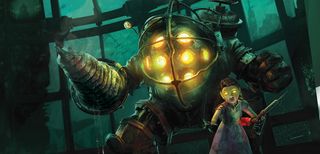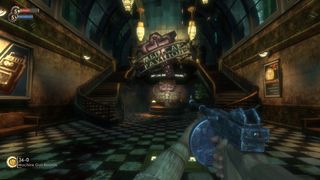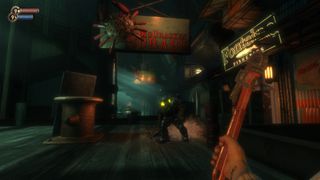Alone in Rapture: why vulnerability was Bioshock's greatest strength

Every conversation I’ve ever heard about gameplay and story usually ends with gameplay winning out. When we play video games, we want good gameplay. It’s a requirement. You don’t need a story worthy of the Western Canon for a game like Dark Souls or Serious Sam. They’re great because of their gameplay: that bundle of mechanics, feedback, and level design that sets video games apart from other media. But what happens when a game with bad or mediocre gameplay comes along and gets praised as one of the best video games ever made?
Bioshock is one such game. It’s a classic. It’s so well-liked that a sequel with different characters, gameplay, and setting was hugely anticipated and hyped to the moon and back. But… if you talk to most people about Bioshock today, they’ll probably tell you that the gameplay wasn’t that great. It wasn't what kept them playing. So why is Bioshock routinely cited as one of the greatest games of all time?
I think it’s all about vulnerability. Conventional wisdom dictates that shooters are about empowerment, about players being the toughest guy in the room, but Bioshock was never a particularly good shooter, and it certainly didn’t empower the player. Bioshock stuck with us because it made us vulnerable, not powerful.

Bad shootbangs
"Gameplay" can cover a lot of ground, but for Bioshock, it primarily means shooting. And when you have to use the omnipresent gun in your hand in Bioshock, the gameplay falters.
In a good shooter, enemies are diverse and fun to fight. They respond to being shot. They move around the map, encouraging you to do the same. Likewise, a good shooter has guns that sound and feel good to use. A huge number of factors influence gun feel, from how guns affect enemies (by making them stumble, for instance), to how they sound, to how they’re animated. Bioshock’s gunplay didn’t live up to these standards.
Likewise, Bioshock’s plasmids weren’t as diverse or interesting as they could have been—many of them were merely the same element reskinned with slight, mostly meaningless differences. Good gunplay is like a roller coaster—the more varied the experience, the better it is. In order to have fun, players need to experience both tension and triumph. Without a proper balance between the two, the game becomes flat. A flat roller coaster isn’t all that fun to ride, is it? At some point, it just becomes a really crappy train, and who wants to ride that?
It’s not like Bioshock was all bad ideas, of course. Setting up arenas before fighting a Big Daddy was cool, as was turning turrets and security bots to your side. Crafting ammunition types with unique strengths or weaknesses was always a delight. But the vita chamber system robbed the player of vulnerability set up in the game’s more successful mechanics. Shoot someone in the face, die, respawn, and now you’ve got fewer enemies to deal with. With them, there’s no risk or reward in Bioshock’s combat: just keep chipping away at your foes until they’re dead; your victory is as inevitable as nightfall. Vita chambers flatten the roller coaster; without vulnerability, the risk and reward that makes combat engaging is lost, but that’s not all.
PC Gamer Newsletter
Sign up to get the best content of the week, and great gaming deals, as picked by the editors.
Turn them off, though, and Bioshock’s combat falls in line with the game’s quieter, more powerful moments, that window of gameplay that didn't involve shooting splicers. Suddenly, we’re not completely safe.

The power of vulnerability
We loved Bioshock because it was tense—because we were vulnerable. It’s that initial climb on the roller coaster. We know what’s coming, we can see it up ahead, part of us dreading it and the other part impatiently waiting... and then it hits, time slows for an instant, and we rush downward in one thrilling moment. Vulnerability gives way to catharsis.
If we look back to classic shooters, the idea of vulnerability pops up a lot. From Half-Life to Aliens vs Predator, a lonely, vulnerable player overcoming the odds is a standard experience. By 2007, shooters had moved away from this, focusing more on a more heroic, unstoppable player.
But Bioshock was different. Bioshock was the spiritual sequel to System Shock 2.
Like Bioshock, System Shock 2’s combat was less than inspiring, but the game succeeded because of its emphasis on player vulnerability. It was a game about being a lone hacker facing off the mutant crew of a dying spaceship. System Shock 2 was tense and thrilling, a game well worth revisiting even now. Yes, it had shooting, but System Shock 2 wasn’t a shooter. It was more of a sci-fi horror simulator.
When you beat a Big Daddy, you feel a rush because you just overcame the odds. You just did the impossible.
Both of these games thrived on vulnerability. It wasn’t so much about shooting people as it was about being there, in the moment. Up until the “would you kindly” moment, Bioshock presented a world that still felt real, where you were just a guy with a wrench trying to survive against superpowered maniacs and walking tanks with father complexes.
Killing a Big Daddy is fun because Big Daddies are hard to kill. You’ve got to set up traps, distract them with splicers, hack turrets to gain additional support, and make sure you’ve got enough supplies to see an encounter through. It’s the cars slowly rising up the hill, readying for the apex. Attacking the Big Daddy is like cresting the hill and rushing down it, a moment of furious ecstasy. When you beat a Big Daddy, you feel a rush because you just overcame the odds. You just did the impossible.
So, how do you create vulnerability?
Most Popular

